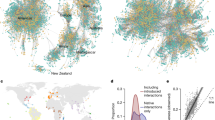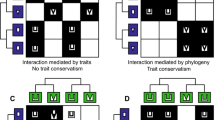Abstract
The late Quaternary megafaunal extinction impacted ecological communities worldwide, and affected key ecological processes such as seed dispersal. The traits of several species of large-seeded plants are thought to have evolved in response to interactions with extinct megafauna, but how these extinctions affected the organization of interactions in seed-dispersal systems is poorly understood. Here, we combined ecological and paleontological data and network analyses to investigate how the structure of a species-rich seed-dispersal network could have changed from the Pleistocene to the present and examine the possible consequences of such changes. Our results indicate that the seed-dispersal network was organized into modules across the different time periods but has been reconfigured in different ways over time. The episode of megafaunal extinction and the arrival of humans changed how seed dispersers were distributed among network modules. However, the recent introduction of livestock into the seed-dispersal system partially restored the original network organization by strengthening the modular configuration. Moreover, after megafaunal extinctions, introduced species and some smaller native mammals became key components for the structure of the seed-dispersal network. We hypothesize that such changes in network structure affected both animal and plant assemblages, potentially contributing to the shaping of modern ecological communities. The ongoing extinction of key large vertebrates will lead to a variety of context-dependent rearranged ecological networks, most certainly affecting ecological and evolutionary processes.




Similar content being viewed by others
References
Abreu UGP, McManus C, Santos SA (2010) Cattle ranching, conservation and transhumance in the Brazilian Pantanal. Pastoralism 1:99–114
Almeida-Neto M, Guimarães P, Guimarães PR, Loyola RD, Ulrich W (2008) A consistent metric for nestedness analysis in ecological systems: reconciling concept and measurement. Oikos 117:1227–1239
Asner GP, Levick SR, Kennedy-Bowdoin T, Knapp DE, Emerson R, Jacobson J, Colgan MS, Martin RE (2009) Large-scale impacts of herbivores on the structural diversity of African savannas. Proc Natl Acad Sci USA 106:4947–4952
Assine ML, Soares PC (2004) Quaternary of the Pantanal, west-central Brazil. Quatern Int 114:23–34
Barber MJ (2007) Modularity and community detection in bipartite networks. Phys Rev E 76:e0066102
Barnosky AD, Lindsey EL (2010) Timing of Quaternary megafaunal extinction in South America in relation to human arrival and climate change. Quatern Int 217:10–29
Bascompte J, Jordano P (2007) Plant-animal mutualistic networks: the architecture of biodiversity. Annu Rev Ecol Evol Syst 38:567–593
Bascompte J, Jordano P, Melián CJ, Olesen JM (2003) The nested assembly of plant—animal mutualistic networks. Proc Natl Acad Sci USA 100:9383–9387
Brodie JH, Helmy OE, Brockelman WY, Maron JL (2009) Functional differences within a guild of tropical mammalian frugivores. Ecology 90:688–698
Bueno RS, Guevara R, Ribeiro MC, Culot L, Bufalo FS, Galetti M (2013) Functional redundancy and complementarities of seed dispersal by the last neotropical megafrugivores. PLoS One 8:e56252
Bush MB, Gosling WD, Colinvaux PA (2011) Climate change in the lowlands of the Amazon Basin. In: Bush MB, Flenley JR, Gosling WD (eds) Tropical rainforest responses to climate change. Springer, Berlin Heidelberg New York, pp 61–84
Campos-Arceiz A, Traeholt C, Jaffar R, Santamaria L, Corlett RT (2012) Asian tapirs are no elephants when it comes to seed dispersal. Biotropica 44:220–227
Corlett RT (2013) The shifted baseline: prehistoric defaunation in the tropics and its consequences for biodiversity conservation. Biol Conserv 163:13–21
Donatti CI, Galetti M, Pizo MA, Guimarães PR, Jordano P (2007) Living in the land of ghosts: fruit traits and the importance of large mammals as seed dispersers in the Pantanal, Brazil. In: Dennis AJ, Schupp EW, Green RJ, Westcott DA (eds) Seed dispersal: its theory and application in a changing world. CABI, Wallingford, pp 104–123
Donatti CI, Guimarães PR, Galetti M, Pizo MA, Marquitti FMD, Dirzo R (2011) Analysis of a hyper-diverse seed dispersal network: modularity and underlying mechanisms. Ecol Lett 14:773–781
Donlan CJ et al (2006) Pleistocene rewilding: an optimistic agenda for twenty-first century conservation. Am Nat 168:660–681
Doughty CE, Wolf A, Malhi Y (2013) The legacy of the Pleistocene megafauna extinctions on nutrient availability in Amazonia. Nat Geosci 6:761–764
Dunne JA (2006) The network structure of food webs. In: Pascual M, Dunne JA (eds) Ecological networks: linking structure to dynamics in food webs. Oxford University Press, New York, pp 27–86
Dunne JA, Williams RJ, Martinez ND (2002) Network structure and biodiversity loss in food webs: robustness increases with connectance. Ecol Lett 5:558–567
Effiom EO, Nuñez-Iturri G, Smith HG, Ottosson U, Olsson O (2013) Bushmeat hunting changes regeneration of African rainforests. Proc R Soc B 280:1759
Fortuna MA et al (2010) Nestedness versus modularity in ecological networks: two sides of the same coin? J Anim Ecol 79:811–817
Fragoso JMV, Silvius KM, Correa JA (2003) Long-distance seed dispersal by tapirs increases seed survival and aggregates tropical trees. Ecology 84:1998–2006
Galetti M (2004) Parks of the Pleistocene: recreating the Cerrado and the Pantanal with megafauna. Nat Conserv 2:93–100
Galetti M, Dirzo R (2013) Ecological and evolutionary consequences of living in a defaunated world. Biol Conserv 163:1–6
Galetti M et al (2013) Functional extinction of birds drives rapid evolutionary changes in seed size. Science 340:1086–1090
Gill JL (2013) Ecological impacts of the late Quaternary megaherbivore extinctions. New Phytol 201:1163–1169
Gill JL, Williams JW, Jackson ST, Lininger KB, Robinson GS (2009) Pleistocene megafaunal collapse, novel plant communities, and enhanced fire regimes in North America. Science 326:1100–1103
Griffiths CJ, Hansen DM, Jones CG, Zuel N, Harris S (2011) Resurrecting extinct interactions with extant substitutes. Curr Biol 21:762–765
Guimarães PR, Galetti M, Jordano P (2008) Seed dispersal anachronisms: rethinking the fruits extinct megafauna ate. PLoS One 3:e1745
Guimarães PR, Jordano P, Thompson JN (2011) Evolution and coevolution in mutualistic networks. Ecol Lett 14:877–885
Guimerà R, Amaral LAN (2005) Functional cartography of complex metabolic networks. Nature 433:895–900
Guix JC (2009) Amazonian forests need indians and caboclos. ORSIS Org Sist 24:33–40
Hansen DM, Galetti M (2009) The forgotten megafauna. Science 324:42–43
Jansen PA, Hirsch BT, Emsens WJ, Zamora-Gutierrez V, Wikelski M, Kays R (2012) Thieving rodents as substitute dispersers of megafaunal seeds. Proc Natl Acad Sci USA 109:12610–12615
Janzen DH (1984) Dispersal of small seeds by big herbivores—foliage is the fruit. Am Nat 123:338–353
Janzen DH (1986) Chihuahuan desert nopaleras: defaunated big mammal vegetation. Annu Rev Ecol Syst 17:595–636
Janzen DH, Martin PS (1982) Neotropical anachronisms—the fruits the gomphotheres ate. Science 215:19–27
Johnson CN (2009) Ecological consequences of late Quaternary extinctions of megafauna. Proc R Soc B 276:2509–2519
Koch PL, Barnosky AD (2006) Late Quaternary extinctions: state of the debate. Annu Rev Ecol Evol Syst 37:215–250
Krause AE, Frank KA, Mason DM, Ulanowicz RE, Taylor WW (2003) Compartments revealed in food-web structure. Nature 426:282–285
MacFadden BJ (2000) Cenozoic mammalian herbivores from the Americas: reconstructing ancient diets and terrestrial communities. Annu Rev Ecol Syst 31:33–59
MacFadden BJ, Shockey BJ (1997) Ancient feeding ecology and niche differentiation of Pleistocene mammalian herbivores from Tarija, Bolivia: morphological and isotopic evidence. Paleobiology 23:77–100
Marquitti FMD, Guimarães PR, Pires MM, Bittencourt LF (2014) MODULAR: software for the autonomous computation of modularity in large network sets. Ecography 37:221–224
Martin PS, Klein RG (1984) Quaternary extinctions: a prehistoric revolution. University of Arizona Press, Tucson
May RM (1972) Will a large complex system be stable? Nature 238:413–414
Memmott J, Waser NM, Price MV (2004) Tolerance of pollination networks to species extinctions. Proc R Soc B 271:2605–2611
Nathan R, Muller-Landau HC (2000) Spatial patterns of seed dispersal, their determinants and consequences for recruitment. Trends Ecol Evol 15:278–285
Olesen JM, Bascompte J, Dupont YL, Jordano P (2007) The modularity of pollination networks. Proc Natl Acad Sci USA 104:19891–19896
Olesen JM, Bascompte J, Elberling H, Jordano P (2008) Temporal dynamics in a pollination network. Ecology 89:1573–1582
Owen-Smith N (1987) Pleistocene extinctions—the pivotal role of megaherbivores. Paleobiology 13:351–362
Petanidou T, Kallimanis AS, Tzanopoulos J, Sgardelis SP, Pantis JD (2008) Long-term observation of a pollination network: fluctuation in species and interactions, relative invariance of network structure and implications for estimates of specialization. Ecol Lett 11:564–575
Pimm SL (2002) Food webs. University of Chicago Press, Chicago
Pires MM, Guimarães PR, Araújo MS, Giaretta AA, Costa JCL, dos Reis SF (2011) The nested assembly of individual-resource networks. J Anim Ecol 80:896–903
Pott A, Oliveira AKM, Damasceno GA, Silva JSV (2011) Plant diversity of the Pantanal wetland. Br J Biol 71:265–273
Rezende EL, Lavabre JE, Guimarães PR, Jordano P, Bascompte J (2007) Non-random coextinctions in phylogenetically structured mutualistic networks. Nature 448:925–928
Roosevelt AC et al (1996) Paleoindian cave dwellers in the Amazon: the peopling of the Americas. Science 272:373–384
Rule S, Brook BW, Haberle SG, Turney CSM, Kershaw AP, Johnson CN (2012) The Aftermath of megafaunal extinction: ecosystem transformation in Pleistocene Australia. Science 335:1483–1486
Salles LO, Cartelle C, Guedes PG, Boggiani PC, Janoo A, Russo CAM (2006) Quaternary mammals from Serra da Bodoquena, Mato Grosso do Sul, Brazil. Bol Mus Nacl Rio de Janeiro 521:1–12
Scheffler SM, Martins GR, Kashimoto EM, de Oliveira AM (2010) Revisão sobre a paleontologia no estado do Mato Grosso do Sul: fósseis e afloramentos descritos. Braz Geogr J Geosci Humanit Res Medium 1:65–99
Scoles R, Gribel R (2011) Population structure of Brazil nut (Bertholletia excelsa, Lecythidaceae) stands in two areas with different occupation histories in the Brazilian Amazon. Hum Ecol 39:455–464
Smith FA et al (2003) Body mass of late Quaternary mammals. Ecology 84:3403
Terborgh J, Estes JA (2010) Trophic cascades: predators, prey, and the changing dynamics of nature. Island Press, Washington, DC
Thébault E (2013) Identifying compartments in presence-absence matrices and bipartite networks: insights into modularity measures. J Biogeogr 40:759–768
Vidal MM, Pires MM, Guimarães PR (2013) Large vertebrates as the missing components of seed-dispersal networks. Biol Conserv 163:42–48
Vilà M et al (2009) Invasive plant integration into native plant-pollinator networks across Europe. Proc R Soc B 276:3887–3893
Whitney BS et al (2011) A 45 kyr palaeoclimate record from the lowland interior of tropical South America. Palaeogeogr Palaeoclimatol Palaeoecol 307:177–192
Wright SJ et al (2007) The plight of large animals in tropical forests and the consequences for plant regeneration. Biotropica 39:289–291
Zaya DN, Howe HF (2009) The anomalous Kentucky coffeetree: megafaunal fruit sinking to extinction? Oecologia 161:221–226
Acknowledgments
We thank D. M. Hansen, P. Jordano and two anonymous reviewers for critical suggestions regards the manuscript. M. M. P., M. G. and P. R. G. were supported by São Paulo Research Foundation (FAPESP; grant nos. 2009/54422-8, 2004/00810-3, 2008/10154-7, and 2009/54567-6). C. I. D. was supported by Stanford University. M. G., P. R. G. and M. A. P. receive research grants from CNPq. We also thank the Earthwatch Institute and Conservation International for financial support and Conservation International, Lucas Leuzinger and Marina Schweizer for their permission to work on their properties.
Author information
Authors and Affiliations
Corresponding author
Additional information
Communicated by Candace Galen.
Electronic supplementary material
Below is the link to the electronic supplementary material.
Rights and permissions
About this article
Cite this article
Pires, M.M., Galetti, M., Donatti, C.I. et al. Reconstructing past ecological networks: the reconfiguration of seed-dispersal interactions after megafaunal extinction. Oecologia 175, 1247–1256 (2014). https://doi.org/10.1007/s00442-014-2971-1
Received:
Accepted:
Published:
Issue Date:
DOI: https://doi.org/10.1007/s00442-014-2971-1




